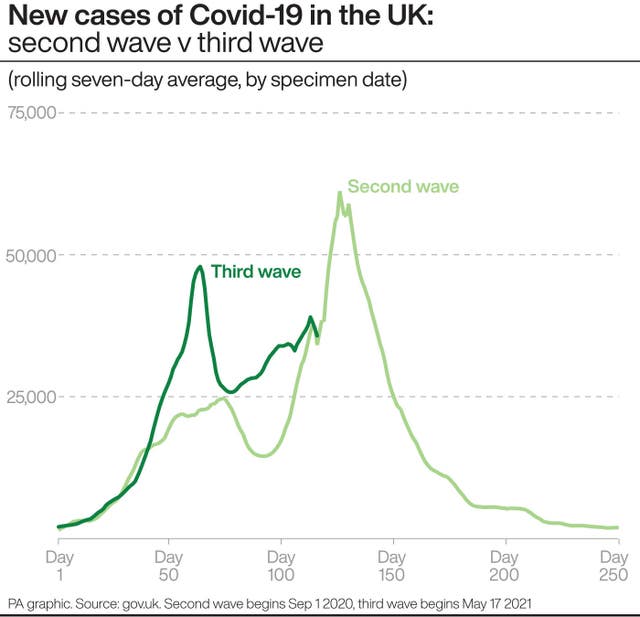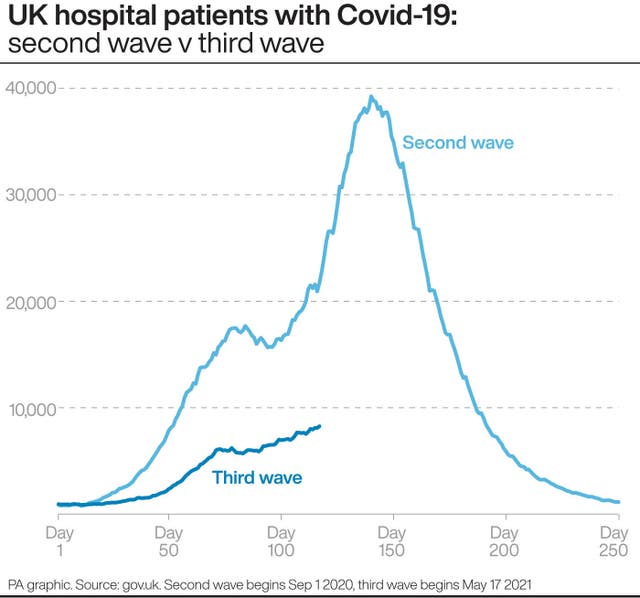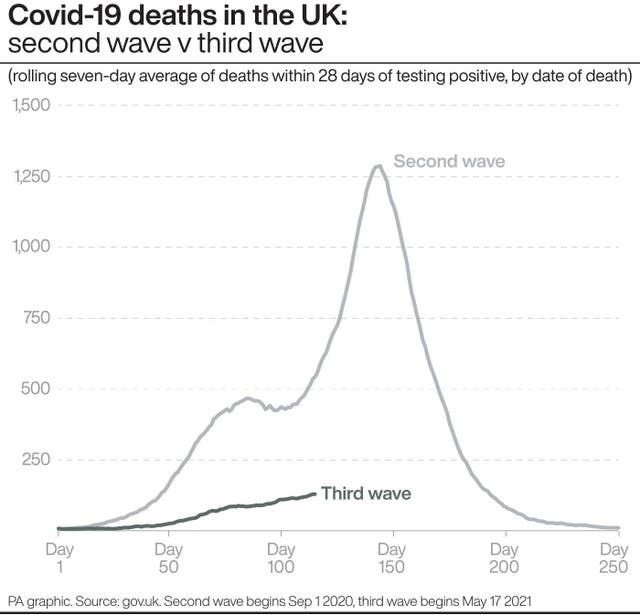Third wave of Covid-19 in the UK: What are the latest numbers?
It is too soon to say whether the current wave has peaked.

Covid-19 patient numbers and deaths in the UK are continuing to rise slowly, although both remain well below levels seen during the last wave of the virus, latest figures show.
The Government is today setting out its plan for tackling Covid-19 during the autumn and winter, including offering more than 30 million people a booster dose of vaccine.
Here is a snapshot of the latest data for coronavirus cases, hospital patients and deaths.
All figures have been compiled by the PA news agency from the latest official Government data, and use September 1 2020 as the start of the second wave and May 17 2021 as the start of the third wave.
– Cases
The average number of daily recorded cases of Covid-19 in the UK stood at 35,746 on September 9 (data for more recent days is incomplete).
Cases have averaged between 30,000 and 40,000 for the past few weeks, but there is currently no clear trend upwards or downwards.
The latest average of 35,746 is slightly higher than at the equivalent point during the second wave (day 116, or December 25), when the average stood at 34,103.

Cases were rising sharply at this stage in wave two, however.
This was due to to the spread of the Alpha variant of the virus, first detected in Kent, plus the easing of coronavirus restrictions in the weeks before Christmas.
The second wave peaked at an average of just over 61,000 cases on day 126 (January 4), then fell sharply as the UK went back into full lockdown.
By contrast, the third wave has taken place against the backdrop of an easing of almost all lockdown restrictions across the UK, combined with the spread of the more transmissible Delta variant.
This has already led to a sharp rise in new cases during late June and early July, peaking at an average of nearly 50,000 a day, coinciding with the Euro 2020 football tournament which saw large crowds of people mixing at stadiums, pubs and other venues.
The average number of cases then dipped briefly below 30,000 in early August, before climbing back above 30,000 in mid-August where it has remained ever since.
The autumn could bring a renewed rise in cases driven by more mixing of people at schools, universities and workplaces, or by a drop in levels of immunity provided by vaccines.
But while the third wave has already seen cases reach levels higher than those in the early stage of the second wave, the same is not true for the volume of hospital patients or deaths.
– Hospital patients
The number of patients in hospital in the UK with Covid-19 stood at 8,256 on September 10, the most recent date for which figures are available.
This is up 8% week-on-week and is the highest level since March 10, when the total stood at 8,436.
Patient numbers are still well below levels seen in the second wave, however.

At the equivalent point in wave two (day 117, or December 26), the total had already reached 21,730.
Numbers then rose steeply, peaking at 39,254 on day 140 (January 18 2021).
The increase was driven by the spread of the Alpha variant of coronavirus, together with a pre-Christmas relaxation in coronavirus restrictions across the UK.
Vaccinations were also still at a very early stage, with the first doses being administered on December 8.
The situation today is very different. Nearly 66% of the UK population is now fully vaccinated against Covid-19, with vaccines estimated to have averted at least 143,600 hospital admissions among people aged 65 and over in England alone.
At the same time, little or no restrictions concerning socialising and hygiene are currently in place, events involving large crowds – such as music festivals and sporting fixtures – are happening for the first time since the pandemic began, and schools have returned for a new term.
There is certainly the potential for hospital numbers to carry on rising, but how far and how fast is unclear.
– Deaths
The average number of deaths each day of people who have died within 28 days of testing positive for Covid-19 stood at 129 on September 8 (data for more recent days is incomplete).
At the equivalent point in wave two of the virus (day 115, or December 24), average daily deaths stood at 542, more than four times as high.

Deaths during the third wave so far have remained consistently well below those seen during the second wave, when they peaked at an average of 1,286 a day.
This again reflects the success of the vaccination programme, with figures for England suggesting the vaccines have so far directly averted around 112,300 deaths.
There has been an increase in the average number of deaths since the third wave began.
But the rise has been slow and the numbers are still at a very low level: from eight deaths on day one (May 17) to 25 deaths by day 50 (July 5), and 110 deaths by day 100 (August 24).
As with hospital patients, there is the potential for these numbers to carry on rising and at a faster rate.
If a jump in the number of people with Covid-19 translates into a jump in those needing hospital care for the virus, past evidence suggests this will be followed by a jump in deaths.
And with around a third of the population not fully vaccinated, plus about one in four young adults yet to receive a first dose, there are plenty of people who could still fall seriously ill from coronavirus.





